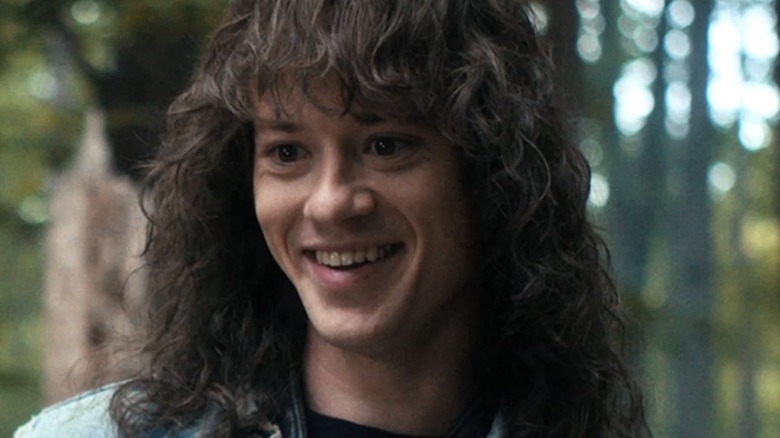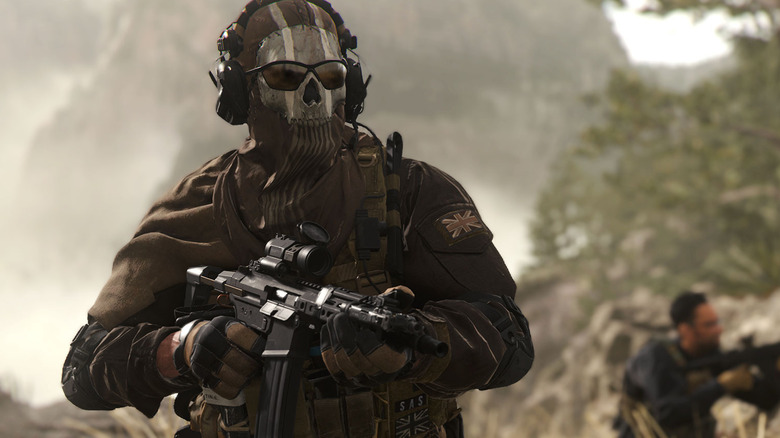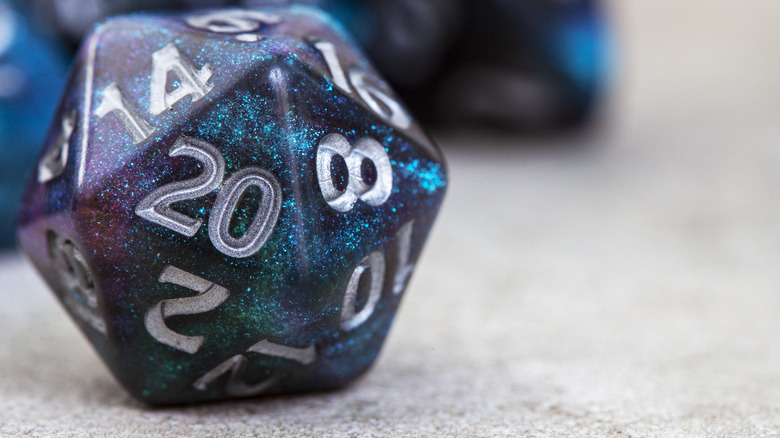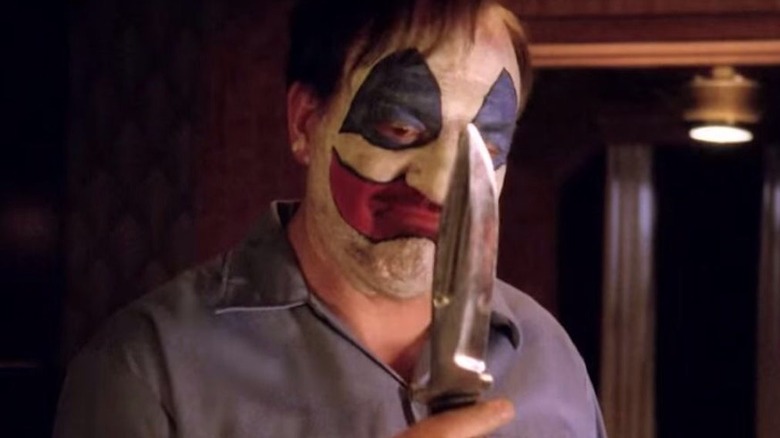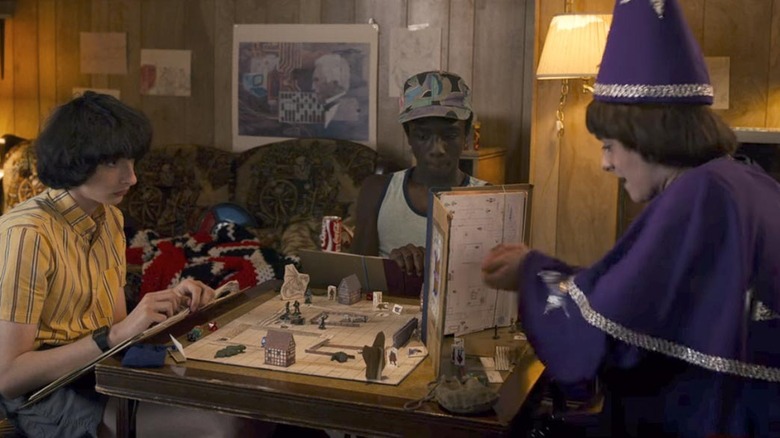Before Video Games Caused Violence, 60 Minutes Told Us That Dungeons & Dragons Did
In the 4th season of "Stranger Things," a few of the leading kids join a "Dungeons & Dragons" (D&D) group at their school called The Hellfire Club. "D&D" has always been an essential part of "Stranger Things." As avid players of the tabletop RPG, when weird things happen in Hawkins, the gang uses their vast knowledge of the monsters in the game to explain real-life occurrences.
"D&D" is where names like the Demogorgon, the Mind Flayer, and Vecna come from. The powerful forces that plague Hawkins are named after monsters from the game that display similar features and abilities. For the entirety of the series, there's a lot of emphasis on "Dungeons & Dragons." However, it isn't until "Stranger Things 4" that the kids' love of the game is ever called into question.
When Chrissy, a beloved cheerleader at Hawkins High, dies in Eddie Munson's (Joseph Quinn) trailer, vengeful eyes turn on Eddie's Hellfire Club. As the Dungeon Master of the group, Eddie is considered the leader. The accusations go from 0 to 100 quickly, as mass panic eventually leads the town to believe that not only is Eddie a murderer, but he's also the leader of a satanic cult (Hellfire), and the recent murders are a string of ritualistic sacrifices.
This entire plot line seemed like a gross exaggeration, but in the 1980s, there were a lot of nasty misconceptions about the game that mirrored "Stranger Things 4."
Many factors lead to using video games as a scapegoat
Modern society loves to blame video games for violent behavior in gamers. There's a large range of video games that put the player in control of a character who chooses to be violent for a number of reasons. Because video games can be extremely violent, people love to use them as a scapegoat for violent behavior even though it's been disproven.
The American Psychological Association wrote an article in 2019 about the correlation between blaming video games and violent crimes. Lead researcher Patrick Markey, Ph.D., said, "When a violent act is carried out by someone who doesn't match the racial stereotype of what a violent person looks like, people tend to seek an external explanation for the violent behavior. When a white child from the suburbs commits a horrific violent act like a school shooting, then people are more likely to erroneously blame video games than if the child was African American."
In a CNN article, Oxford University Associate Professor Andrew Przybylski discussed scapegoating media older generations don't understand. "Society has a concern about new technology, parents or policymakers get involved, and maybe the researchers don't have much experience with the technology themselves, and so the first few attempts to study the thing are pretty poorly done," Przybylski said. He further insisted, "the evidence has become pretty clear that, where there are correlations, it's probably because of a third factor."
Przybylski also pointed out that gamers are extremely diverse worldwide, yet the trend for blaming violent behavior on violent games tends to come from the U.S., where mass shootings have become a severe problem. If these patterns are only showing up in the States, but video games are played everywhere, how could they be the cause?
Before video games were popular, D&D suffered the same ridicule
Although "Dungeons & Dragons" is a tabletop game, it's still a game where the player gets to create a character and role-play the character through scenarios where they get to be a hero, a villain, or a neutral party. "D&D" has an elaborate combat system that includes a wide variety of weaponry and magic; each character specializes in their own abilities.
In 1985, "60 Minutes" aired an episode all about how "D&D" led young players to die by suicide or commit murder. This footage is shocking to watch today because of the gross exaggerations presented by the narrator and the interviewees. Not only do they blame "D&D," they wholeheartedly believe that this game they simply don't understand is at fault for horrible tragedies and acts of violence. The entire episode is framed from an extremely biased perspective. It feels like the audience is only given a limited range of information on the cases that deliberately make "D&D" look at fault every time.
Watching this video feels surreal because the violent hatred towards "D&D" doesn't seem like it could be real. However, compared to the modern argument against video games, it starts to add up. People will always look for scapegoats, and it's usually found in media that is easily misunderstood by older generations.
If you or anyone you know is having suicidal thoughts, please call the National Suicide Prevention Lifeline by dialing 988 or by calling 1-800-273-TALK (8255).
D&D became entangled with the Satanic Panic of the '80s
Dicebreaker did an extensive article about the history of "Dungeons & Dragons" and how it correlated to the Satanic Panic of the 1980s. Due to multiple killings through the late '60s and '70s, like the Manson Family murders and those perpetrated by the Zodiac Killer, Ted Bundy, John Wayne Gacy, and many others, mass panic spread like wildfire. Many of the killings were attributed to cults and left behind evidence that seemed ritualistic. This era of violent crimes and murders eventually led to the Satanic Panic movement.
Unfortunately, "Dungeons & Dragons" became a main target of the Satanic Panic movement, as the game found itself under many accusations that it festered cult-like behavior. This is what "Stranger Things" Season 4 emulated so well by pinning the blame for the Hawkins curse and Vecna's murders on the Hellfire Club's leader, Eddie Munson.
The "60 Minutes" episode features Patricia Pulling, the first real person to speak out against "Dungeons & Dragons." She even started BADD (Bothered About Dungeons and Dragons), a campaign designed to warn people of the game's dangers. Pulling lost her son to suicide and she was convinced that it was tied to her child's involvement with the game.
Much like the Satanic Panic was the main worry of the 1980s, mass shootings have become a modern concern. "D&D" was to the Satanic Panic movement what video games have become to extreme gun violence.
As D&D became more popular, it took more heat
"60 Minutes" isn't the only example of media blaming "Dungeons & Dragons" for tragedy. In fact, one of Tom Hanks' earliest projects was a 1982 TV movie called "Mazes and Monsters," a film dedicated to demonizing "D&D" by focusing on a group of college students who get so wrapped up in their fantasy role-playing game, that tragedy ensues. The film was based on a 1981 book by Rona Jaffe based on the case of Michigan State University student James Dallas Egbert III, whose month-long disappearance in 1979 was blamed on his obsession with "Dungeons & Dragons," as explained by Tor. The fact that a future A-lister like Hanks unintentionally helped the campaign against "D&D" speaks volumes for how demonized it was at the time.
As the game became more popular, there were more incidents of kids who enjoyed the game being caught up in something horrible. Mary Towey's murder in 1984 and Leith Von Stein's murder in 1988 were connected to "D&D" because the alleged killers played the game. One of Towey's murderers, Darren Molitor, even blamed playing the game for why he did it. These incidents only fanned the flames of the game's "accountability." The backlash was a good thing at first, as more people became interested in playing. Still, as the connection between Satanic Panic and "D&D" grew, it started to hurt the brand.
TSR, the original company that owned the game, hired Joyce Brothers, a psychologist who vouched for the game's safety to try and combat the backlash, but it wasn't enough. With the mass panic sweeping through the United States, more and more people hastily — and unfairly — blamed a game for horrible things happening rather than looking for the actual cause.
